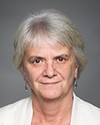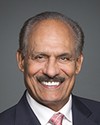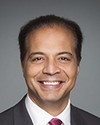Thank you, Mr. Chair.
It's not a region that many people know very much about. I enjoyed the last comments that were made about the interconnectivity. Part of the former Soviet Union absolutely connected to Europe, absolutely connected to the east.
I was just in Washington last week and met with the other four central Asian ambassadors and they all reminded me that whereas in 1991, after the collapse of the former Soviet Union, the majority of the trade was with Russia. A majority of the trade for most of these countries now is with Europe. There are a couple, like Tajikistan and Uzbekistan, that still trade predominantly with Russia but they have forged new relationships.
As we maintain our relationship with the United States, they maintain their relationship with their traditional partners, which in some circles are called the spheres of influence: Russia and China. However, they have forged new relationships that are bilateral, multilateral, and international. It is these international organizations and relationships that will make the difference in terms of prodding them—and one ambassador actually used that verb—to move forward in modernizing their economy, modernizing their governance structures, and modernizing who they speak with and how they speak.
The OSCE and NATO are critical—and I'm sorry that I missed the first part of Joan's presentation—and the OSCE in Russia is still respected. Those organizations are also our Canadian eyes and ears on the ground in that region. There are a lot of Canadians who operate with NATO and the OSCE.
I also want to mention someone who has been in the news a lot most recently, and that is His Highness, the Aga Khan. He runs a public-private sector operation in Kazakhstan, Kyrgyzstan, Tajikistan, and Afghanistan. It is a critical and majority investor in some of these countries, particularly Kyrgyzstan and Tajikistan. The focus is on microfinancing, education, and training young people to look for jobs.
I'm not even following my presentation, but you'll have it if you need it.
What is really important is that there are approximately 67 million people in central Asia. Unlike the west, where the majority of demographics are older, 40% of the demographics are 30 years and younger. Unlike some of you, I understand from the Kazakh ambassador, having recently been in Kazakhstan in Astana, that Astana is not at all like Uzbekistan, Kyrgyzstan, Tajikistan, Afghanistan, or Turkmenistan. The poverty is not like what we see when we look at Africa, for example, or the traditional third world countries. The poverty and the economic growth are uneven. The legacy issues are corruption, governance, and just not knowing how to move forward.
After 1991—and I was in Moscow during the coup—there was a Soviet general who said, “We lost the Baltic fleet; we will never lose the Black Sea fleet.” In 1992, already, they knew what their imperial and their historical—as they would term it—tendencies would be in central Asia and in the former Soviet Union.
There are 67 million people in central Asia—I'm not counting Afghanistan because it is a separate issue—of whom, as I said, 40% are young. It used to be that if they did not find jobs, as migrant labourers, they would go predominantly to Russia, and secondly to Kazakhstan. As the economy and commodity prices shrank, those young and middle-aged people were stopped at the borders. Migrant labour, carrying drugs, and carrying illicit arms were pretty lucrative, but more lucrative—when they were stuck and not able to cross the border into Russia—was radicalization.
Radicalization cannot be underestimated in central Asia. At any one given time, there are seven million people on the move in central Asia. These are predominantly Muslim countries. They are secular governments and totally firm against terrorism, but since the collapse in 1991 of the former Soviet Union, there is also a search for a value system. The Soviet Union came with a value system. Post-1991, the only “ism” that appeared on the horizon was capitalism, and the only direction that was provided by the west was democracy.
They were traders from the Silk Road, way before the drugs, centuries ago. It was china, grain, then drugs, then narcotics, then illicit trade in human beings, and now it's terrorism. I was reminded by my defence colleagues that there is nothing new about ideologies and there is nothing new about terrorism. They have existed for centuries. What is new is technology.
The other issue is that these migrant workers, or these young, radicalized fighters, return home. They are brothers and they are fathers, and they are sisters. They come back to their villages and they are embraced as their own, and no one knows who has been radicalized.
I have reports on insurgents' activities, but there is always a lot more than what happens. In an example last week that did not make the press, 17 people were arrested in Kazakhstan—and I quote the ambassador—“as a preventative measure”. We won't hear from those 17 people again. These governments are interested in stability. They know that their relationships to new partners and to economic growth are critical to their sovereignty. They're not interested in terrorism. It is something that will take them in a direction that they have never been interested in.
Each country in central Asia is a little different. They have long-standing ties to Russia and to Europe. In 1923, when the former Soviet Union closed its borders—unimaginable that you could close such a large country—central Asia was doubly closed. That was where the nuclear weaponry was being developed. That is where there are still—and I've been in five of them—biological and chemical weapons labs, and they're not terribly secure. They have wooden tables that they work on, doors that don't lock, and screen windows where the air goes back and forth, and everything that is carried by air is transmitted to the region. Tajikistan and southern Kyrgyzstan are probably in the worst shape, in terms of diseases and chemical and biological weapon transfer. It doesn't cost very much; pay somebody $100 and they can go into a lab and get it.
As a result of the Soviet Union—Moscow at that point—doing these tests and doing this development, nobody had even heard of these countries. When we speak of Samarkand, many people still think that it might be in India or Pakistan. I often compare the old Silk Road to the Hudson's Bay Company in Canada. These were traders from a long time ago.
In addition, their 77 years in the former Soviet Union trained them to work really hard, in double, triple, and quadruple jobs. These are people who have a huge work ethic and who have had to survive under many different disputes, conflicts, and wars.
In addition, central Asia is where the labour camps were, not the concentration camps. That's another reason central Asia was closed. It speaks to why it is such a tolerant, inclusive, multi-ethnic, multilingual, and multireligious region. In those labour camps were the Russians, who didn't tow the line, the Ukrainians, the Volga Dutch, the Volga Germans, the Poles, the Greeks, and the Koreans.
In these countries you have Muslims, Buddhists, Christians, Jews, and Hindus. Everybody is there. They survived. They are intermarried. Religion isn't a fanatic thing for them of course, because of their time under the Soviet Union, but Islamism, in its—I'm going to use this word with my apologies—perversion, has frightened them. These governments are interested in stability. They know that their sovereignty, as nations independent of Russia and China, and their economic stability depends on their governance and their anti-terrorism. They are looking for models.
The European Union is doing a lot within central Asia in sectors of production like food processing—on top of the machinery Canada brings in—in terms of mining, in terms of co-operation on nuclear non-proliferation.
These countries do not have weapons now. Between Russia and the United States there are approximately 1,800 nuclear weapons. Some of the weaponry has been hidden in—I don't want to call it eastern Europe because in the old American nomenclature it was called the eastern bloc—countries that are now part of the EU. Shortly after the collapse of 1991, there was some weaponry hidden in some of those poorer eastern bloc countries.
I believe what my colleague said. Interconnectivity, economic interdependence, and the work of multilateral, international, and bilateral partnerships are key, and radicalization cannot be underestimated.




